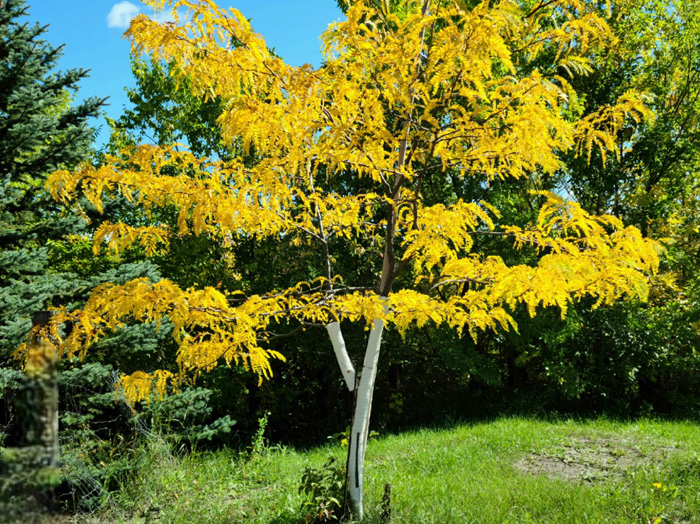Deeply Rooted
Locusts of the Prairie

Am I talking about what John the Baptist ate in the desert? Honey and Locust? No this is a new to Manitoba tree that have been grown in southern Minnesota for a long time. About 15 years ago a variety called prairie silk Honey Locust came on the market. It was relatively hardy in a sheltered area, however it did tip freezes a little on tough winter days. That set back aside though it would grow a couple of feet per year. Then 5 years later there was a slightly hardier variety called Northern Queen Honey Locust became available. This one is seedless. We have seen both selections do quite well, but another variety, Northern Acclaim, does not seem too tip freeze in winter if growing in an area protected from the north and west. There is one are you in front of the house at the nursery. It is exposed to a fair bit of Northwind but almost no Northwest or west wind.
Why would we consider selling or growing this species, if it doesn’t love the cold why carry it? Well it does have some completely unique features unlike any other native or introduced trees we carry. From an aesthetic perspective it has an open airy horizontal branching pattern, so it only produces light shade. Most intriguing is the tiny glossy leaflets that remind me of a fern. It is unusual for a large tree to have such small leaves. Do not be misled to believe that these leaves are delicate. They have a bit of a glossy plastic look and are resilient to heat and wind. One final benefit, aesthetically speaking is its fall colour! It has a gorgeous golden yellow colour that will stand out among the rest, making it an excellent feature plant for the yard.
Most people prefer not to clean up seed but this one has a very unique looking seed pod. For all those tiny little leaves it contrasts itself by having large flat pea pods that curl like wavy hair. The pods can be up to 15″ long! They remain on the tree until late fall or early winter. The easiest way to clean them up is in Spring. If that sounds like work, remember that Northern Acclaim does not have any seed, so no need for clean up. One of the strengths of this species that was mentioned earlier is that its fast growing. The second would be its drought tolerance once established. Those are great, but my favourite features are still its unique structure and leaf. It looks like an African Acacia style tree.
I mentioned earlier that they were growing mostly in Mid-Minnesota and south. Over the last 15 to 20 years many have been planted in North Dakota. Fargo has quite a few on the streets. In Grand Forks there are several large trees at the Southwest entrance of the mall. Probably planted there because of its drought tolerance.
I know of at least three in Niverville at the 20+ ft height. Steinbach has also introduced several of them in the parks in the past few years. If you have a sheltered, hot or dry spot and you appreciate something different, this could be a good tree to pursue.




